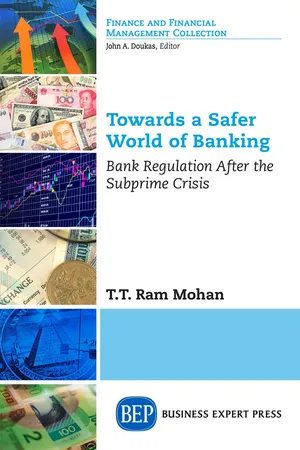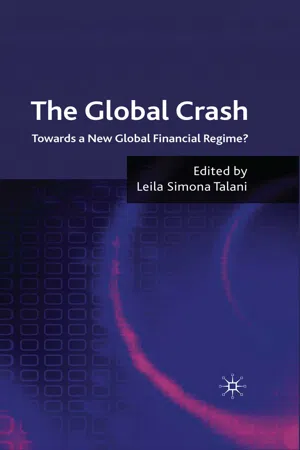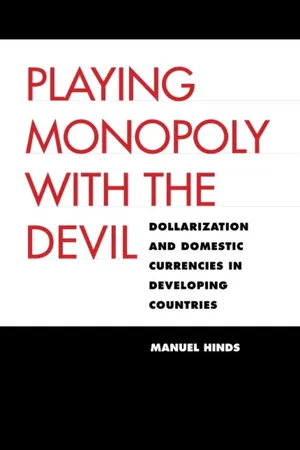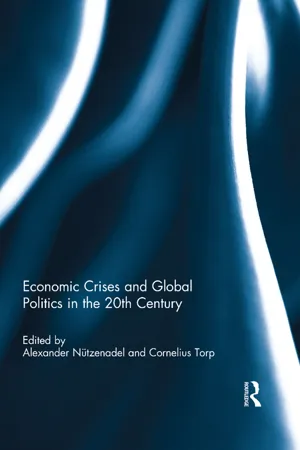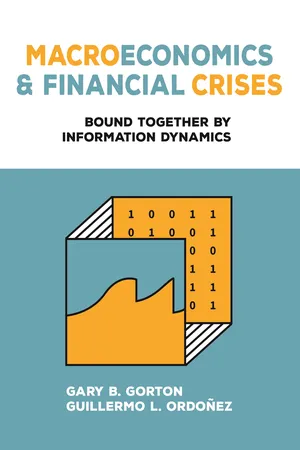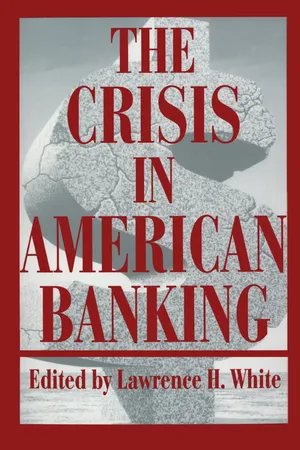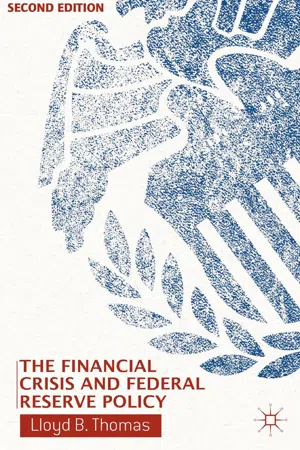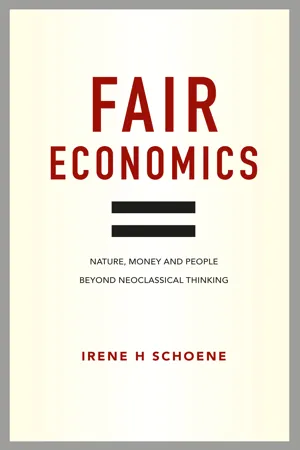Economics
Banking Crisis
A banking crisis refers to a situation where a large number of banks or financial institutions experience significant financial distress or fail altogether. This can lead to a loss of confidence in the banking system, causing widespread panic and economic instability. Banking crises often result in government intervention to stabilize the financial sector and prevent further economic damage.
Written by Perlego with AI-assistance
Related key terms
1 of 5
12 Key excerpts on "Banking Crisis"
- eBook - PDF
Unsettled Account
The Evolution of Banking in the Industrialized World since 1800
- Richard S. Grossman(Author)
- 2010(Publication Date)
- Princeton University Press(Publisher)
Finally, crises can have substantial effects on the structure of the banking system. These include a decrease in the number and assets of financial institutions, a corresponding increase in banking concentra-tion, a greater scope for direct government involvement in banking, and substantial changes in the regulatory environment. Financial Crises and Banking Crises Surprisingly, for a phenomenon that has been the focus of much attention by academics, journalists, and policy makers for more than two centu-ries, there is no consensus definition of a financial crisis. Hyman Minsky (1982b: 13) asserts that a definition is unnecessary, since the major epi-sodes can be identified by pointing. Kindleberger (1978: 21–22) argues that “. . . the genus ‘crises’ should be divided into species labeled commer-cial, industrial, monetary, banking, fiscal, financial (in the sense of finan-cial markets), and so on, or into groups called local, regional, national, and international.” Eichengreen and Portes (1987: 10), like Kindleberger, recognize the multifaceted nature of financial crisis, yet devise a unified definition of crisis as “. . . a disturbance to financial markets, associated typically with falling asset prices and insolvency among debtors and in-termediaries, which ramifies through the financial system, disrupting the market’s capacity to allocate capital . . .” This contrasts with Friedman and Schwartz’s (1963) focus on liquidity shortage as the hallmark of fi-nancial crises and Schwartz’s (1986) classification of asset price declines and other financial disturbances in the absence of such a shortage as “pseudo-crises.” Banking Crises • 55 Although “Banking Crisis” is a narrower category than “financial cri-sis,” it is not possible to completely disentangle banking crises from the other types of associated financial disturbances (Jonker and van Zanden 1995). - eBook - ePub
- T.T. Ram Mohan(Author)
- 2017(Publication Date)
- Business Expert Press(Publisher)
Banking crises are pervasive, frequent, and impose huge costs on economies. There are numerous studies that document the pervasiveness, frequency, and costs of banking crises. What constitutes a Banking Crisis? How do we mark the starting and ending dates of a crisis? How do we estimate the costs of a crisis? Definitions and methodologies vary.Here, we look at some of the studies that have attempted answers to these questions. Their findings will help us understand just how disruptive banking crises are.Laeven and Valencia document 147 episodes of banking crises, involving 115 countries, in the period 1970–2011.6 Clearly, some countries have had multiple crises in the period. The authors define a systemic Banking Crisis as one that satisfies one or both of the following criteria:- There are significant signs of financial distress in the banking system, indicated by bank runs, large bank losses, and bank liquidations.
- The government responds to losses in the banking system through significant policy intervention measures.
- Extensive liquidity support (in excess of 5 percent of deposits and liabilities to nonresidents)
- Gross restructuring cost of over 3 percent of GDP (we will elaborate a little later on gross and net restructuring costs)
- Significant bank nationalizations (government takeovers and control of systemically important financial institutions)
- Significant guarantees have been put in place (either full protection of deposits or guarantees of nondeposit liabilities)
- Significant asset repurchases (over 5 percent of GDP)
- Deposit freezes or bank holidays
The authors note that there are instances where governments have intervened on a large scale but without necessarily using three or more of the earlier measures. So they think it a sufficient condition for a crisis to be regarded as systemic if banking system losses exceed 20 percent of loans (or closures of 20 percent of the banking system) or if the fiscal restructuring cost exceeds 5 percent of GDP. - eBook - PDF
The Global Crash
Towards a New Global Financial Regime?
- L. Talani(Author)
- 2010(Publication Date)
- Palgrave Macmillan(Publisher)
1 The Banking Crisis: Causes, Consequences and Remedies Paul De Grauwe The basics of banking In order to analyse the causes of the Banking Crisis it is useful to start from the basics of banking. 1 Banks are in the business of borrowing short and lending long. In doing so they provide an essential service to the rest of us, that is, they create credit that allows the real economy to grow and expand. This credit creation service, however, is based on an inherent fragility of the banking system. If depositors are gripped by a collective move- ment of distrust and decide to withdraw their deposits at the same time, banks are unable to satisfy these withdrawals, as their assets are illiquid. A liquidity crisis erupts. In normal times, when people have confidence in the banks, these crises do not occur. But confidence can quickly disappear, for exam- ple, when one or more banks experience a solvency problem due to non-performing loans. Then bank runs are possible. A liquidity crisis erupts that can bring down sound banks also. The latter become inno- cent bystanders that are hit in the same way as the insolvent banks by the collective movement of distrust. The problem does not end here. A devilish interaction between liq- uidity crisis and solvency crisis is set in motion. Sound banks that are hit by deposit withdrawals have to sell assets to confront these with- drawals. The ensuing fire sales lead to declines in asset prices, reducing the value of banks’ assets. This in turn erodes the equity base of the banks and leads to a solvency problem. The cycle can start again: the solvency problem of these banks ignites a new liquidity crisis and so on. The last great Banking Crisis occurred in the 1930s. Its effects were devastating for the real economy. After that crisis the banking system 10 Paul De Grauwe 11 was reformed fundamentally. These reforms were intended to make such a Banking Crisis impossible. - eBook - PDF
Why Are There So Many Banking Crises?
The Politics and Policy of Bank Regulation
- Jean-Charles Rochet(Author)
- 2009(Publication Date)
- Princeton University Press(Publisher)
PART 1 Why Are There So Many Banking Crises? This page intentionally left blank Chapter One Why Are There So Many Banking Crises? Jean-Charles Rochet 1.1 Introduction The last thirty years have seen an impressive number of banking and financial crises all over the world. In an interesting study, Caprio and Klingebiel (1997) identify 112 systemic banking crises in 93 countries and 51 borderline crises in 46 countries since the late 1970s (see also Lindgren et al. 1996). More than 130 out of 180 of the IMF countries have thus experienced crises or serious banking problems. Similarly, the cost of the Savings and Loan crisis in the United States in the late 1980s has been estimated as over USD 150 billion, which is more than the cumulative loss of all U.S. banks during the Great Depression, even after adjusting for inflation. On average the fiscal cost of each of these recent banking crises was of the order of 12% of the country’s GDP but exceeded 40% in some of the most recent episodes in Argentina, Indonesia, South Korea, and Malaysia. Figure 1.1 shows the universality of the problem. These crises have renewed interest of economic research about two questions: the causes of fragility of banks and the possible ways to remedy this fragility, and the justifications and organization of public intervention. This public intervention can take several forms: • emergency liquidity assistance by the central bank acting as a lender of last resort; • organization of deposit insurance funds for protecting the deposi-tors of failed banks; • minimum solvency requirements and other regulations imposed by banking authorities; • and finally supervisory systems, supposed to monitor the activities of banks and to close the banks that do not satisfy these regulations. 22 CHAPTER 1 Figure 1.1. Banking problems worldwide, 1980–96. Light gray, Banking Crisis; dark gray, significant banking problems; white, no significant banking problems or insufficient information. - Robert M Stern, Simon J Evenett(Authors)
- 2011(Publication Date)
- World Scientific(Publisher)
1 Banks are in the business of borrowing short and lending long. In doing so they provide an essential service 1 A very useful book is Goodhart and Illing, (2002). 23 24 P. De Grauwe to the rest of us, i.e., they create credit that allows the real economy to grow and expand. This credit creation service, however, is based on an inherent fragility of the banking system. If depositors are gripped by a collective movement of distrust and decide to withdraw their deposits at the same time, banks are unable to satisfy these withdrawals as their assets are illiquid. A liquidity crisis erupts. In normal times, when people have confidence in the banks, these crises do not occur. But confidence can quickly disappear, for example, when one or more banks experience a solvency problem due to non-performing loans. Then, bank runs are possible. A liquidity crisis erupts that can also bring down sound banks. The latter become innocent bystanders that are hit in the same way as the insolvent banks by the collective movement of distrust. The problem does not end here. A devilish interaction between liq-uidity crisis and solvency crisis is set in motion. Sound banks that are hit by deposit withdrawals have to sell assets to confront these with-drawals. The ensuing fire sales lead to declines in asset prices, reduc-ing the value of banks’ assets. This in turn erodes the equity base of the banks and leads to a solvency problem. The cycle can start again: the solvency problem of these banks ignites a new liquidity crisis and so on. The last great Banking Crisis occurred in the 1930s. Its effects were devastating for the real economy. After that crisis the banking system was fundamentally reformed. These reforms were intended to make such a Banking Crisis impossible. The reforms had three essential ingre-dients. First, the central bank took on the responsibility of being the lender of last resort. Second, deposit insurance mechanisms were insti-tuted.- eBook - PDF
Playing Monopoly with the Devil
Dollarization and Domestic Currencies in Developing Countries
- Manuel Hinds(Author)
- 2008(Publication Date)
- Yale University Press(Publisher)
136 Chapter 7 The Currency Origins of Financial Crises The expression financial crisis evokes two different phenomena. First, it can be used to refer to cataclysmic runs on banks, such as those that took place during the Great Depression of the 1930s. Second, it can be used to refer to widespread insolvency in the banking system, even if there is no run on the banks. In this chapter, I deal with the two phenomena; for clarity, however, I reserve the expression finan-cial crisis for the cataclysmic events associated with severe lack of liquidity. Banking runs are always associated with illiquidity, and illiquidity is frequently associated with insolvency. However, solvent banks can become illiquid if caught in a confidence crisis. Conversely, banks can be insolvent for decades without becoming illiquid if people trust them, if their deposits keep on growing, and if they do not experience a shock that triggers their illiquidity. Everybody knows, for instance, that the Japanese financial system has been insolvent since the early 1990s. However, there has been no run on the Japanese banks. On the contrary, their deposits and other domestic market sources of funds increased by 2.2 percent per year from 1989 to 2002. This has The Currency Origins of Financial Crises 137 been enough to keep them liquid (credit from the central bank to the banks increased by only 1.2 percent of the total market resources during the decade). 1 Insolvent but liquid banks are also common in many developing countries. The environment is more propitious there for these walking-dead institutions, not because people trust their banks more than in developed countries, but because inflation helps weak banks to survive. Figure 7.1 shows how a hy-pothetical bank can manage to survive for twenty years even if it is insolvent from day one. - Alexander Nützenadel, Cornelius Torp(Authors)
- 2016(Publication Date)
- Routledge(Publisher)
This Time is Different ) to also include other kinds of financial crisis in a very long historical period, but still without a proper treatment of money supply. They argue that periods of financial distress have been associated with macroeconomic circumstances, such as economic downturns, declines in income and depressed asset markets that typically follow waves of domestic and international credit expansion. Demigürc-Kunt and Detragiache (1998) have found that low gross domestic product (GDP) growth, excessively high real interest rates, high inflation, adverse terms of trade shocks, the size of the fiscal deficit and the rate of the depreciation of the exchange significantly increase the likelihood of systemic financial problems.Cassis, in Capitals of Capital , studies the shaping of financial systems in the context of eight severe financial crises from the Baring Crises of 1890 to the Financial Debacle of 2007–8. The interesting notion in the book is that financial crises affected the size and ownership structure of banks. Another interesting development illustrated by Cassis is the increase and decrease in banking regulation after a financial crisis. Both of these have had an impact on money supply; nevertheless Cassis’ book totally fails to include money supply as part of the analysis of financial crises. Grossman (Unsettled Account: the Evolution of Banking in the Industrialized World since 1800 ), on the other hand, does take a look at how the volume of bank deposits has been influenced by four major elements of banking evolution: crisis, mergers, bailouts and regulation. The book studies the evolution of commercial banking over two centuries in Western Europe, the United States, Canada, Japan and Australia.III. A chronology of banking crises, 1850–2010
Before discussing the development of banking systems and money supply, I will take a look at how the occurrence of financial crises developed in the last 160 years. The purpose is to identify in the course of that development a pattern in the occasionally increased frequency of financial crises. Instead of talking about public-debt crisis, I choose banking crises as the relevant type of disturbance for the purposes of this paper: banking crises are most closely related to changes in money supply, and thus changes in aggregate production and income.8- eBook - PDF
Macroeconomics and Financial Crises
Bound Together by Information Dynamics
- Gary B. Gorton, Guillermo L. Ordoñez(Authors)
- 2023(Publication Date)
- Princeton University Press(Publisher)
6 The Crisis-Fighting Role of Central Banks 6.1 Chapter Overview In this chapter we add banks and central banks in our setting and study their role when a crisis occurs. The previous chapter showed how stock markets, by generating informa- tion in the economy, can prevent crises. In this chapter we imagine that the crisis was unavoidable and we study the role of central banks in taming the generation of informa- tion that pervades credit in the economy. Central banks do this by opening emergency lending facilities. We study the optimal design of those facilities in affecting information in credit markets and restoring confidence. As lending facilities operate through banks, we explicitly introduce financial intermedi- aries in this chapter. Households are born with endowments already deposited in a bank. A bank is an institution that also has its own funds and has the proprietary access to two productive investment opportunities. One, which we denote collateral, generates an asset that is pledgeable and the other, which we denote project, is stochastic, ex ante efficient, and not pledgeable. The first will be financed with its own resources and is then used to col- lateralize the deposits to finance the second. Put simply, banks use assets in their portfolio as collateral for deposits to finance new assets. The underlying problem in the economy, as in previous chapters, is a scarcity of good collateral in banks’ portfolios. When good collateral is scarce, an efficient substitute, as before, is ignorance about which private assets used as collateral are good and which are bad, as in the absence of information even banks with bad collateral can maintain their deposits and invest in the project. A crisis happens when an (exogenous) event occurs (a fall in home prices, for instance) causing depositors to run, defined here as the demand to examine the bank’s portfolio and withdraw if the bank has bad collateral. - eBook - ePub
The Bank Credit Analysis Handbook
A Guide for Analysts, Bankers and Investors
- Jonathan Golin, Philippe Delhaise(Authors)
- 2013(Publication Date)
- Wiley(Publisher)
52. This last category can be broken down further into practices that (a) are motivated by genuine good faith convictions about the role banks should play not only as key components of the financial system, but also as transmitters of government social policy; and (b) are motivated by personal gain. More specifically, the two subcategories would respectively include (a) intervention into bank decisions to effect social policies through policy lending (also called directed lending or connected lending); as well as the (b) tolerance or active promotion of cronyism (e.g., where banks make loans at the behest of government officials for personal or partisan reasons) or corrupt practices (e.g., where a government official in exchange for favors or the expectation or promise of future favors uses the power of the state to invidiously discriminate against certain institutions to the detriment of the health of the banking industry or that of the public interest as a whole).53. A list of such categories that was prepared in the context of early warning systems both for banking and currency crises is provided in a later section.54. See generally David O. Beim, “What Triggers a Systemic Banking Crisis?” Columbia University Working Paper, June 19, 2001, 5. Beim concludes that a bank crisis may be triggered by the withdrawal of funding by one or more of more agents: (1) depositors; (2) the local government, as guarantor; (3) private external lenders; and (4) intergovernmental financial institutions.55. A. Lamfalussy, Financial Crises in Emerging Markets (New Haven, CT: Yale University Press, 2000).56. - eBook - PDF
- Lawrence H. White(Author)
- 1993(Publication Date)
- NYU Press(Publisher)
As I argue below, central banking and legal restric-tions have institutionalized unsaf e banking . Today's bankin g crisi s i s onl y th e lates t i n a lon g serie s o f U.S . banking crise s blame d o n banker s bu t actuall y cause d b y govern-ment intervention. A quick review of our banking history makes the point. Th e mer e mentio n o f wildca t banking' ' conjure s u p image s of reckles s bankin g practice s o n the America n frontie r i n the nine-teenth century , eve n thoug h i t wa s governmen t interventio n tha t promoted suc h practices. 3 Mone y panics' ' i n th e lat e nineteent h century wer e alway s caus e fo r alarm , politica l demagoguery , an d reform movement s aime d at checking the power of bankers, even though governmen t interventio n brough t o n thos e panic s a s well. 4 The stock market crash of 1929 and the collapse of more than a third of all banks in the Grea t Depression of the earl y 1930 s were blamed on excesses in the financial syste m and by the bankers of the time, although i t wa s late r demonstrate d tha t irresponsibl e Federa l Re - Bankers as Scapegoats 8 3 serve policy create d the boom and the bust. 5 In the past decade, the stupendous demis e of the S& L industry, the breakdown of commer -cial banking , an d th e collaps e o f deposi t insuranc e ar e onl y th e latest example s o f crisi s i n America n banking . Bu t thes e too , ar e scandals lai d primaril y a t the fee t o f the bankers, eve n though gov -ernment intervention made them possible (Salsma n 1990) . In the next section I discuss the nature of banking crises and offe r a framewor k fo r understandin g wh y banker s ar e mad e scapegoat s for suc h crises . - eBook - ePub
- L. Thomas(Author)
- 2013(Publication Date)
- Palgrave Macmillan(Publisher)
Chapter 2 The Nature of Banking Crises I. Introduction The United States has experienced more than ten banking crises since the beginning of the twentieth century. This chapter begins by outlining a theory that helps us understand why such crises occur over and over again in nations throughout the world. These crises are also seldom confined to a single country—they strongly tend to occur in clusters, with numerous nations almost simultaneously experiencing the same problems. The Great Crisis of 2007–2009 proved to be contagious, quickly spreading from the United States to many parts of the globe. The underlying forces behind this phenomenon and the various channels through which crises are transmitted from country to country are explored in this chapter. Because the Great Crisis caught U.S. officials by surprise, this chapter discusses the contentious issue of whether careful monitoring of emerging patterns may make it possible to foresee or predict crises, and thus take measures to lessen their impact. Finally, the chapter analyzes the macroeconomic fallout from banking crises and explains why the associated economic contractions tend to be more damaging than recessions that occur in the absence of financial crises. II. The Minsky Theory of Financial Crises In a series of works published in the 1980s and early 1990s, Hyman Minsky developed an important theory of financial crises. 1 This theory helps us understand the forces that create financial crises and explains why these crises occur with such regularity. Minsky spent most of his career at academic institutions such as Brown, Berkeley, and Washington University in St. Louis. He died in 1997. Perhaps because the United States and other highly developed nations experienced an unusual period of sustained economic stability in the quarter century extending from the severe 1981–1983 worldwide recession through about 2006, Minsky’s work received relatively little attention during his lifetime - eBook - PDF
Fair Economics
Nature, money and people beyond neoclassical thinking
- Irene Schoene(Author)
- 2015(Publication Date)
- Green Books(Publisher)
Consequently it would be much less risky for every economy if no branch would be allowed to grow to such importance, especially one which trades the MEANS for all economic actions. So when the banking crises swept from the US to Europe, the government of the United Kingdom had to step in and find a solution to stop bankrupt banks from bringing the whole economy down. With Northern Rock, the UK govern- ment was the first public body using taxpayers’ money to bail out failing banks. 9.5.3.2. Reasons for the Banking Crisis The Banking Crisis was triggered by the fact that American banks were equipped with insufficient proprietary capital, while being overloaded with losses from mortgages (as the banks’ customers were not able to pay them back) and the results of highly risky investments – or rather: gambles – and so called structured financial derivatives. Note: the higher interests/profits offered the more risky the investment. The banks had loaned money – at low interest rates – to people they convinced could and should own a house, but who in reality weren’t able to meet their obligations when the interest rate started rising. It turned out that the banks had been not careful enough to check the financial solidity of their customers. Previously, it had been normal practice for banks to examine the creditworthiness of those looking for mortgages very thoroughly. Now it was all about selling. The banks satisfied themselves that prospective borrowers had enough annual incomes or assets, that they could shoulder the monthly pay back rates as the relationship between borrowers and banks would typically last up to 25 years. Then the 256 FAIR ECONOMICS borrower would finally own the house, the deeds of which were clear of obligation. During this lengthy period the bank could look forward to a steady income from the borrower’s monthly pay-back.
Index pages curate the most relevant extracts from our library of academic textbooks. They’ve been created using an in-house natural language model (NLM), each adding context and meaning to key research topics.

